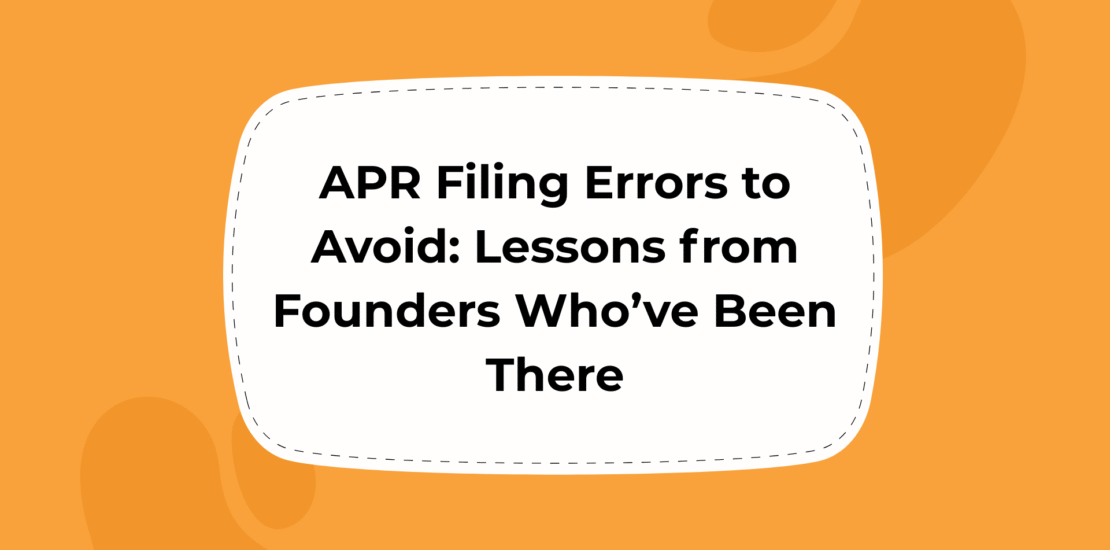APR Filing Mistakes to Avoid: Lessons from Founders Who’ve Been There
- June 30, 2025
- Posted by: Noushed Shaikh
- Category: Uncategorized

APR filing mistakes are more common than many Indian founders realize. When businesses expand overseas, growth and customers often take priority but crucial filings like the Annual Performance Report (APR) tend to be overlooked. Required by the RBI for companies investing abroad under the ODI route, the APR is not optional. Missing it can lead to penalties, funding delays, or blocked remittances.
At LedgersCFO, we’ve worked with founders who’ve faced these APR filing mistakes. In this guide, we’ll break down the most frequent APR filing mistakes and share lessons learned from real-world experiences.
What Is the APR and Why Does It Matter?
The Annual Performance Report (APR) is a yearly filing that summarizes the financial position and activities of your overseas entity. It must be submitted through your Authorized Dealer (AD) Bank to the RBI, even if your foreign venture made no income or remains inactive.
An incomplete or delayed APR can trigger compliance flags, making it difficult to send further capital abroad or receive approvals for future overseas plans.
Common APR Filing Mistakes Indian Founders Make

1. Assuming No Activity Means No Filing
Ravi, the founder of a SaaS startup in Hyderabad, believed that his dormant U.S. subsidiary didn’t require an APR since there was no revenue. Unfortunately, the RBI doesn’t see it that way. He received a compliance notice months later.
Lesson: A NIL APR must still be filed for inactive or non-operational entities. Silence is not compliance.
2. Unclear Unaudited Financials
Many founders submit incomplete unaudited financials. They skip key details like liabilities or retained earnings, or use inconsistent formats. RBI expects clean, clear, and complete reports.
Lesson: Organize unaudited financials properly. Don’t leave out critical numbers or formatting.
3. Using Incorrect Entity Details
One founder submitted the APR using their Indian company’s address and PAN instead of their Delaware LLC’s details. The RBI rejected the filing multiple times before the issue was caught.
Lesson: The APR is about your foreign entity, not the Indian parent. Ensure all names, addresses, registration details, and country codes match the overseas records.
4. Mismatch Between Form ODI and APR
Some businesses report capital infusion or ownership details that don’t match their original ODI filing. This causes confusion, delays, and sometimes penalties.
Lesson: Before filing the APR, always revisit your ODI submission. Make sure figures and ownership structures align precisely.
5. Missing or Late Filing
This is the most common and damaging mistake. Since there are no RBI reminders or alerts, APR filings are often overlooked, especially by early-stage founders.
Lesson: Set up annual compliance calendars. Engage professionals or CFO services who will track these timelines for you.
Financial Statements of Foreign Entity Must Be Duly Audited
Under the latest RBI Overseas Investment Regulations (2022), the Annual Performance Report (APR) must also attach audited financial statements of the foreign entity whenever the Indian company holds 10% or more equity or has control in that entity. This audit must be conducted by a practicing chartered accountant.
Real Founder Insight: What One Filing Mistake Can Cost You
An Indian D2C brand expanding to the U.S. forgot to file the APR for two consecutive years. The result? Their RBI remittance channel was blocked, U.S. operations stalled, and their Series A investor flagged compliance risks. It delayed their growth by six months.
This mistake cost them time, credibility, and momentum.
How to File APR the Right Way
Here’s a straightforward checklist we recommend:
- Collect proper financials from your foreign entity and get it audited from a Practicing Chartered accountant
- Match ownership and capital structure with your ODI filing
- Include turnover, net worth, liabilities, and share capital
- File through your AD Bank in the RBI-approved format
- Maintain proof of submission for your records
Check each data point. A mismatch, even in decimal points or entity name spelling, can cause rejection.
How to Fix an APR Filing Rejection
If your APR was rejected, there’s still a clear path forward:
- Identify the reason: was it incomplete data, incorrect format, or mismatched info?
- Revise and resubmit the corrected APR
- Include a clear covering note explaining the issue and your correction
- Submit again through your AD Bank
With proper documentation and explanation, most errors can be fixed without further penalties.
LedgersCFO Can Help You File It Right the First Time
APR filings require accuracy and a deep understanding of both the RBI expectations and how Indian banks handle ODI cases. At LedgersCFO, we’ve worked with over 200 founders navigating these rules.
Here’s how we help:
- We collect and validate financial data from your U.S. or other foreign entity
- Match it to your Form ODI and rectify any inconsistencies
- File your APR through the appropriate AD Bank
- Respond to RBI queries if any arise
Our goal is simple: remove friction, avoid errors, and make compliance a non-issue so you can focus on running your business.
Book a free consultation today. Let’s make your next APR filing smooth and stress-free
FAQs
1. What is the APR in ODI compliance?
The Annual Performance Report (APR) is a mandatory yearly filing submitted to the RBI through your Authorized Dealer (AD) Bank. It details the financials and performance of your foreign subsidiary or joint venture under the Overseas Direct Investment (ODI) framework.
2. Is the APR required even if my foreign company is inactive or earned no revenue?
Yes, the APR must be filed even for dormant or non-operational foreign entities. This is known as filing a NIL APR. Non-filing can still result in compliance issues, regardless of revenue status.
3. What happens if I don’t file the APR on time?
Late or missed APR filings can lead to:
- RBI notices or compliance flags
- Delay or denial of future ODI approvals
- Remittance blocks from your AD Bank
Timely and accurate filing is crucial to avoid regulatory setbacks.
4. How does LedgersCFO help with APR filing?
At LedgersCFO, we assist Indian founders in:
- Collecting and verifying financials from your foreign entity
- Matching the APR data with your original Form ODI
- Filing through your AD Bank in the RBI-approved format
- Responding to queries from the RBI or the bank, if required
With our help, you avoid delays, rejections, and penalties—while staying focused on business growth.

